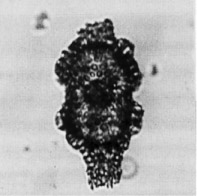 Didymocyrtis
mammifera (Haeckel)
Didymocyrtis
mammifera (Haeckel) Didymocyrtis
mammifera (Haeckel)
Didymocyrtis
mammifera (Haeckel)Cannartidium mammiferum Haeckel, 1887, p.375, pl.39, fig.16
Cannartus mammiferus (Haeckel), Riedel, 1959, p.291, pl.1, fig.4
Cannartus mammifer (Haeckel), Sanfilippo et al., 1973, p.216, pl.1, fig.7
Didymocyrtis mammifera (Haeckel), Sanfilippo and Riedel, 1980, p.1010
Cortical shell ellipsoidal, with an equatorial constriction and with pores subcircular or circular, twelve to fifteen on the half-equator. On the broader parts of the shell, on either side of the equatorial constriction, there are pronounced obtuse moundlike protuberances, at which the shell wall is thickened. At each pole of the cortical shell arises a subcylindrical spongy column with meshes much smaller than those of the cortical shell. Medullary shells two, of which the inner is spherical and the outer spherical or lenticularly compressed. This species differs from [Didymocyrtis violina] in that the protuberances on the cortical shell are mammilliform rather than pliciform (Riedel, 1959).
Based on 20 specimens. Length of polar columns 43-75 µm; median breadth 20-30 µm. Length of cortical shell 110-145 µm; maximum breadth 93-115 µm. Breadth of outer medullary shell 33-43 µm (Riedel, 1959).
This species is distinguished by its mammilliform protuberances on the cortical shell and its subcylindrical spongy columns that cover about one third of the polar ends of the cortical shell (Moore, pers. comm., 1992).
Didymocyrtis violina has thickenings of the cortical shell in the form of coarse plicae rather than tubercles, and D. laticonus has broader polar columns (Sanfilippo et al., 1985).
This form is rarely found well preserved, but even corroded specimens are recognizable on the basis of the cortical shell with distinct tubercular thickenings on its broader parts (not transversely aligned as in Diartus petterssoni) and narrow, spongy polar columns (Sanfilippo et al., 1985).
Didymocyrtis mammifera occurs in late early to middle Miocene assemblages from all oceans in low and middle latitudes, including the Mediterranean region. Its morphotypic first appearance lies within the Stichocorys wolffii Zone and it evolved into Didymocyrtis laticonus within the Dorcadospyris alata Zone.
Didymocyrtis mammifera evolved from D. violina by increased localization of the thickenings on the shell surface.
Additional illustrations can be found in Riedel and Sanfilippo, 1971, pl.2C, figs.1-3; Sanfilippo et al., 1973, pl.1, fig.7.